Vaccines: How They Work and Why Children Should be Immunized
VerifiedAdded on 2023/04/12
|6
|1282
|113
Essay
AI Summary
This essay delves into the science behind vaccines, their mechanisms of action, and the evolution of vaccine technology. It begins with an introduction to infectious diseases and the significance of immunization as a historical breakthrough. The paper explains how vaccines prepare the body's immune system to fight pathogens by stimulating antibody production, emphasizing the difference between traditional and novel vaccine manufacturing methods. It highlights the diseases children in the U.S. are vaccinated against, such as hepatitis, polio, and measles, and underscores the impact of vaccination in reducing mortality rates. Furthermore, the essay addresses common parental misconceptions about vaccines, such as concerns about side effects and the belief that certain diseases are eradicated, and advocates for awareness to dispel these misconceptions. The author recommends child immunization as a safe and effective preventative measure against infectious diseases, reinforcing the importance of vaccinations for both individual and community health. The paper concludes by emphasizing the importance of multiple vaccinations to strengthen a child's immune system.
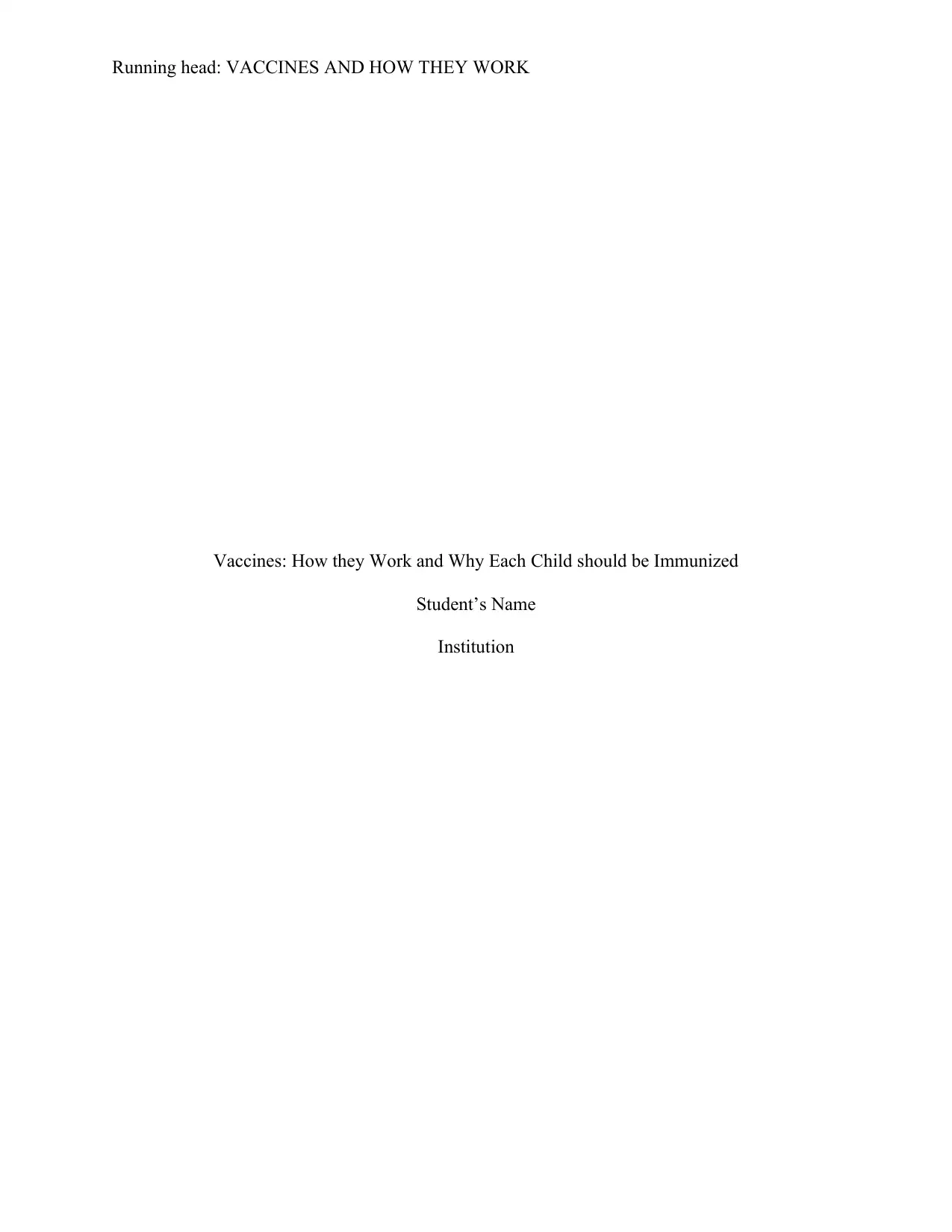
Running head: VACCINES AND HOW THEY WORK
Vaccines: How they Work and Why Each Child should be Immunized
Student’s Name
Institution
Vaccines: How they Work and Why Each Child should be Immunized
Student’s Name
Institution
Paraphrase This Document
Need a fresh take? Get an instant paraphrase of this document with our AI Paraphraser
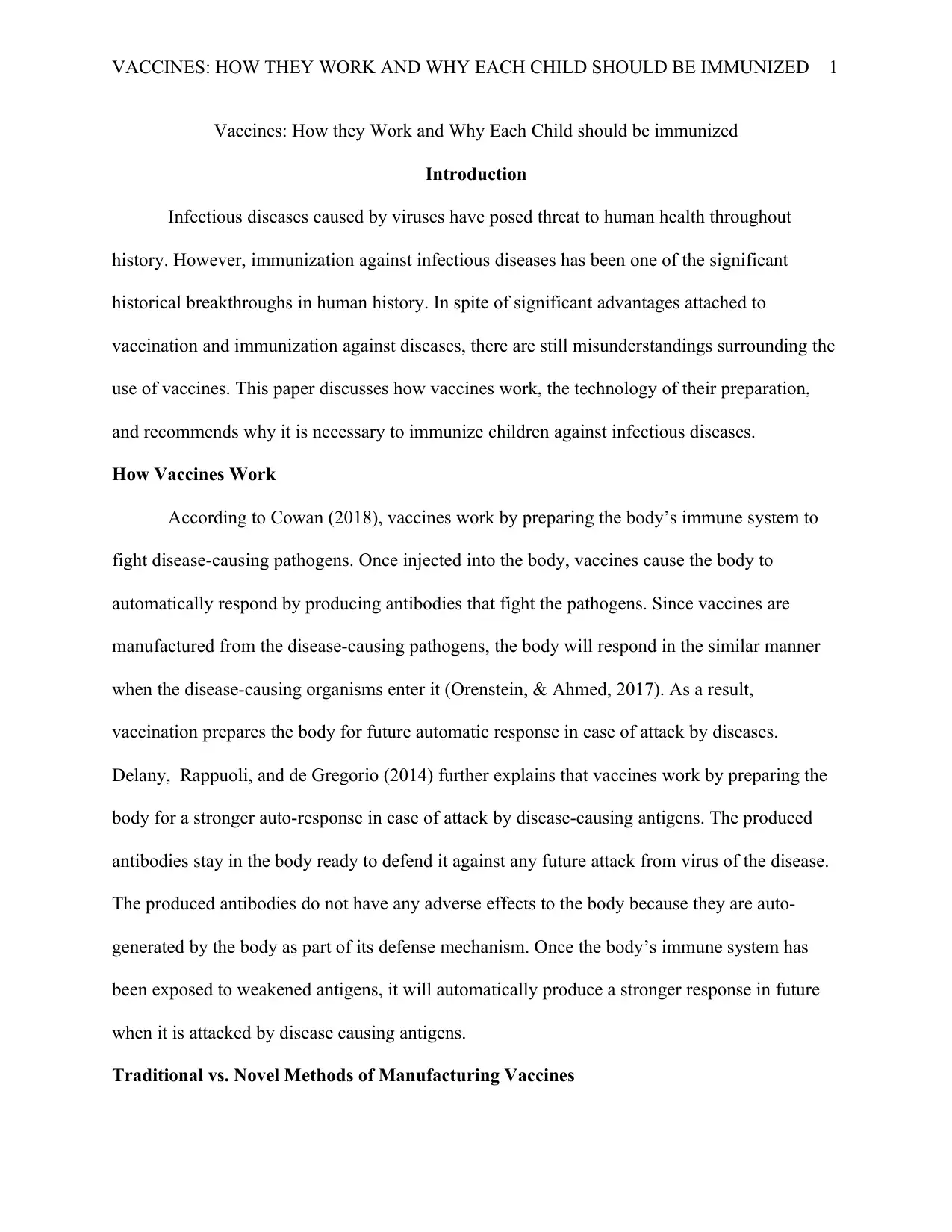
VACCINES: HOW THEY WORK AND WHY EACH CHILD SHOULD BE IMMUNIZED 1
Vaccines: How they Work and Why Each Child should be immunized
Introduction
Infectious diseases caused by viruses have posed threat to human health throughout
history. However, immunization against infectious diseases has been one of the significant
historical breakthroughs in human history. In spite of significant advantages attached to
vaccination and immunization against diseases, there are still misunderstandings surrounding the
use of vaccines. This paper discusses how vaccines work, the technology of their preparation,
and recommends why it is necessary to immunize children against infectious diseases.
How Vaccines Work
According to Cowan (2018), vaccines work by preparing the body’s immune system to
fight disease-causing pathogens. Once injected into the body, vaccines cause the body to
automatically respond by producing antibodies that fight the pathogens. Since vaccines are
manufactured from the disease-causing pathogens, the body will respond in the similar manner
when the disease-causing organisms enter it (Orenstein, & Ahmed, 2017). As a result,
vaccination prepares the body for future automatic response in case of attack by diseases.
Delany, Rappuoli, and de Gregorio (2014) further explains that vaccines work by preparing the
body for a stronger auto-response in case of attack by disease-causing antigens. The produced
antibodies stay in the body ready to defend it against any future attack from virus of the disease.
The produced antibodies do not have any adverse effects to the body because they are auto-
generated by the body as part of its defense mechanism. Once the body’s immune system has
been exposed to weakened antigens, it will automatically produce a stronger response in future
when it is attacked by disease causing antigens.
Traditional vs. Novel Methods of Manufacturing Vaccines
Vaccines: How they Work and Why Each Child should be immunized
Introduction
Infectious diseases caused by viruses have posed threat to human health throughout
history. However, immunization against infectious diseases has been one of the significant
historical breakthroughs in human history. In spite of significant advantages attached to
vaccination and immunization against diseases, there are still misunderstandings surrounding the
use of vaccines. This paper discusses how vaccines work, the technology of their preparation,
and recommends why it is necessary to immunize children against infectious diseases.
How Vaccines Work
According to Cowan (2018), vaccines work by preparing the body’s immune system to
fight disease-causing pathogens. Once injected into the body, vaccines cause the body to
automatically respond by producing antibodies that fight the pathogens. Since vaccines are
manufactured from the disease-causing pathogens, the body will respond in the similar manner
when the disease-causing organisms enter it (Orenstein, & Ahmed, 2017). As a result,
vaccination prepares the body for future automatic response in case of attack by diseases.
Delany, Rappuoli, and de Gregorio (2014) further explains that vaccines work by preparing the
body for a stronger auto-response in case of attack by disease-causing antigens. The produced
antibodies stay in the body ready to defend it against any future attack from virus of the disease.
The produced antibodies do not have any adverse effects to the body because they are auto-
generated by the body as part of its defense mechanism. Once the body’s immune system has
been exposed to weakened antigens, it will automatically produce a stronger response in future
when it is attacked by disease causing antigens.
Traditional vs. Novel Methods of Manufacturing Vaccines
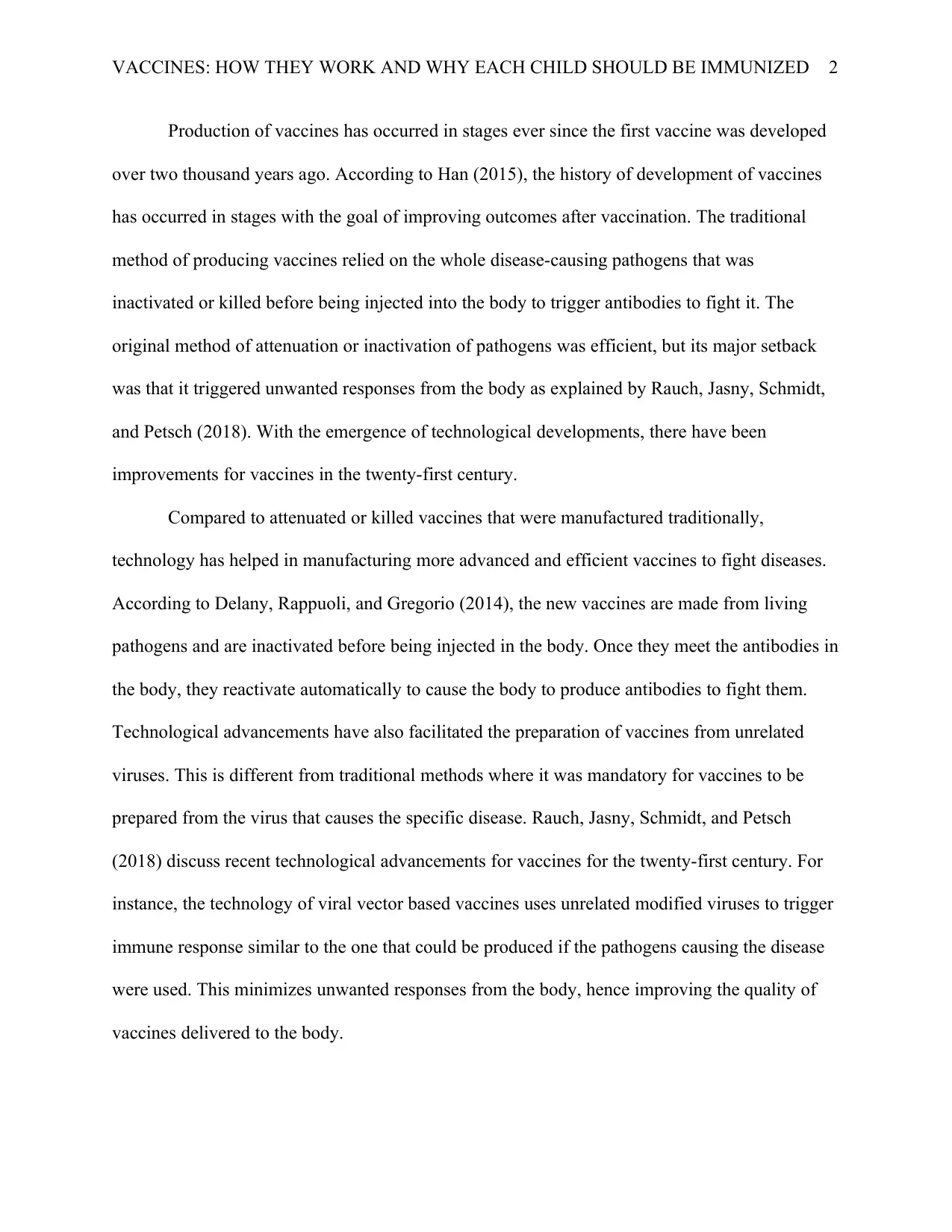
VACCINES: HOW THEY WORK AND WHY EACH CHILD SHOULD BE IMMUNIZED 2
Production of vaccines has occurred in stages ever since the first vaccine was developed
over two thousand years ago. According to Han (2015), the history of development of vaccines
has occurred in stages with the goal of improving outcomes after vaccination. The traditional
method of producing vaccines relied on the whole disease-causing pathogens that was
inactivated or killed before being injected into the body to trigger antibodies to fight it. The
original method of attenuation or inactivation of pathogens was efficient, but its major setback
was that it triggered unwanted responses from the body as explained by Rauch, Jasny, Schmidt,
and Petsch (2018). With the emergence of technological developments, there have been
improvements for vaccines in the twenty-first century.
Compared to attenuated or killed vaccines that were manufactured traditionally,
technology has helped in manufacturing more advanced and efficient vaccines to fight diseases.
According to Delany, Rappuoli, and Gregorio (2014), the new vaccines are made from living
pathogens and are inactivated before being injected in the body. Once they meet the antibodies in
the body, they reactivate automatically to cause the body to produce antibodies to fight them.
Technological advancements have also facilitated the preparation of vaccines from unrelated
viruses. This is different from traditional methods where it was mandatory for vaccines to be
prepared from the virus that causes the specific disease. Rauch, Jasny, Schmidt, and Petsch
(2018) discuss recent technological advancements for vaccines for the twenty-first century. For
instance, the technology of viral vector based vaccines uses unrelated modified viruses to trigger
immune response similar to the one that could be produced if the pathogens causing the disease
were used. This minimizes unwanted responses from the body, hence improving the quality of
vaccines delivered to the body.
Production of vaccines has occurred in stages ever since the first vaccine was developed
over two thousand years ago. According to Han (2015), the history of development of vaccines
has occurred in stages with the goal of improving outcomes after vaccination. The traditional
method of producing vaccines relied on the whole disease-causing pathogens that was
inactivated or killed before being injected into the body to trigger antibodies to fight it. The
original method of attenuation or inactivation of pathogens was efficient, but its major setback
was that it triggered unwanted responses from the body as explained by Rauch, Jasny, Schmidt,
and Petsch (2018). With the emergence of technological developments, there have been
improvements for vaccines in the twenty-first century.
Compared to attenuated or killed vaccines that were manufactured traditionally,
technology has helped in manufacturing more advanced and efficient vaccines to fight diseases.
According to Delany, Rappuoli, and Gregorio (2014), the new vaccines are made from living
pathogens and are inactivated before being injected in the body. Once they meet the antibodies in
the body, they reactivate automatically to cause the body to produce antibodies to fight them.
Technological advancements have also facilitated the preparation of vaccines from unrelated
viruses. This is different from traditional methods where it was mandatory for vaccines to be
prepared from the virus that causes the specific disease. Rauch, Jasny, Schmidt, and Petsch
(2018) discuss recent technological advancements for vaccines for the twenty-first century. For
instance, the technology of viral vector based vaccines uses unrelated modified viruses to trigger
immune response similar to the one that could be produced if the pathogens causing the disease
were used. This minimizes unwanted responses from the body, hence improving the quality of
vaccines delivered to the body.
⊘ This is a preview!⊘
Do you want full access?
Subscribe today to unlock all pages.

Trusted by 1+ million students worldwide
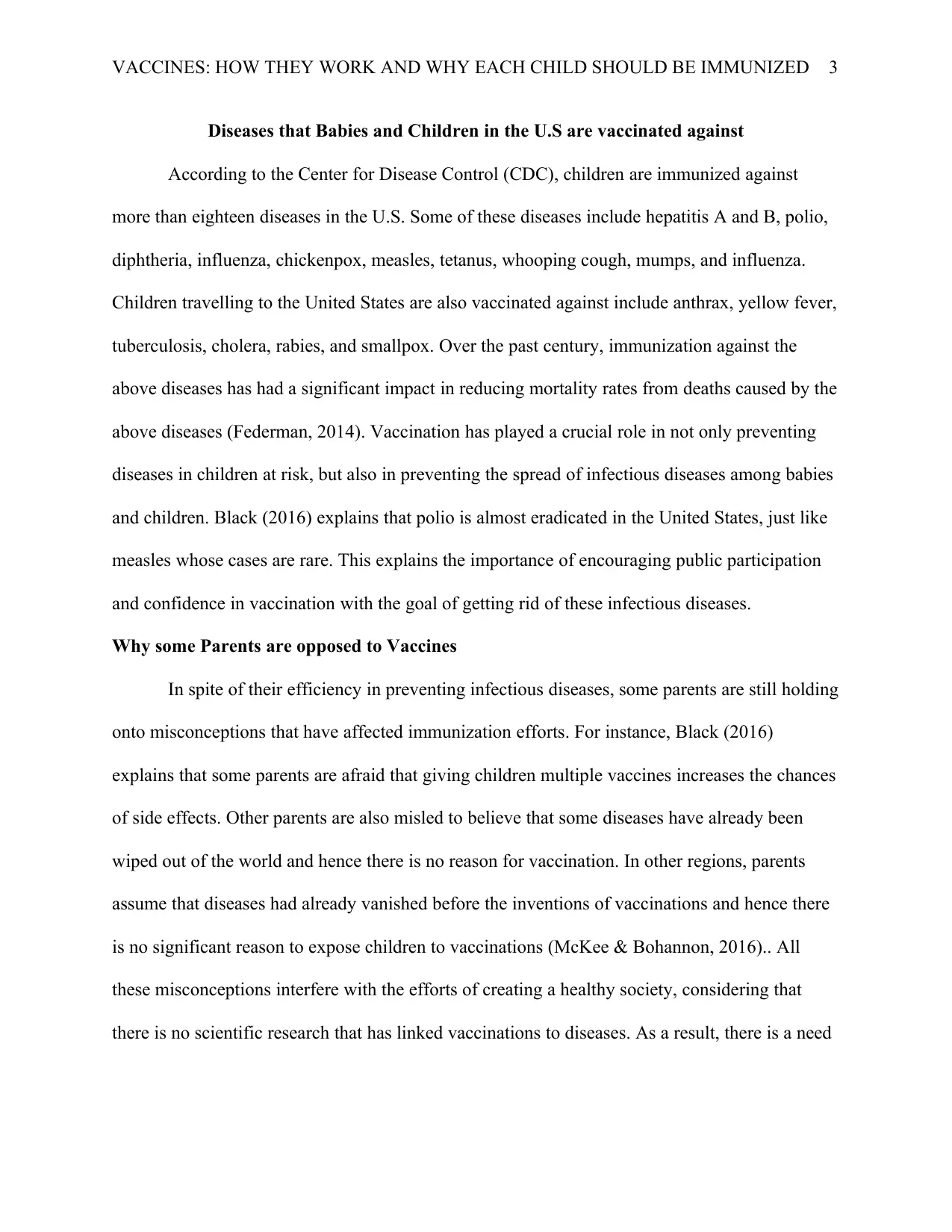
VACCINES: HOW THEY WORK AND WHY EACH CHILD SHOULD BE IMMUNIZED 3
Diseases that Babies and Children in the U.S are vaccinated against
According to the Center for Disease Control (CDC), children are immunized against
more than eighteen diseases in the U.S. Some of these diseases include hepatitis A and B, polio,
diphtheria, influenza, chickenpox, measles, tetanus, whooping cough, mumps, and influenza.
Children travelling to the United States are also vaccinated against include anthrax, yellow fever,
tuberculosis, cholera, rabies, and smallpox. Over the past century, immunization against the
above diseases has had a significant impact in reducing mortality rates from deaths caused by the
above diseases (Federman, 2014). Vaccination has played a crucial role in not only preventing
diseases in children at risk, but also in preventing the spread of infectious diseases among babies
and children. Black (2016) explains that polio is almost eradicated in the United States, just like
measles whose cases are rare. This explains the importance of encouraging public participation
and confidence in vaccination with the goal of getting rid of these infectious diseases.
Why some Parents are opposed to Vaccines
In spite of their efficiency in preventing infectious diseases, some parents are still holding
onto misconceptions that have affected immunization efforts. For instance, Black (2016)
explains that some parents are afraid that giving children multiple vaccines increases the chances
of side effects. Other parents are also misled to believe that some diseases have already been
wiped out of the world and hence there is no reason for vaccination. In other regions, parents
assume that diseases had already vanished before the inventions of vaccinations and hence there
is no significant reason to expose children to vaccinations (McKee & Bohannon, 2016).. All
these misconceptions interfere with the efforts of creating a healthy society, considering that
there is no scientific research that has linked vaccinations to diseases. As a result, there is a need
Diseases that Babies and Children in the U.S are vaccinated against
According to the Center for Disease Control (CDC), children are immunized against
more than eighteen diseases in the U.S. Some of these diseases include hepatitis A and B, polio,
diphtheria, influenza, chickenpox, measles, tetanus, whooping cough, mumps, and influenza.
Children travelling to the United States are also vaccinated against include anthrax, yellow fever,
tuberculosis, cholera, rabies, and smallpox. Over the past century, immunization against the
above diseases has had a significant impact in reducing mortality rates from deaths caused by the
above diseases (Federman, 2014). Vaccination has played a crucial role in not only preventing
diseases in children at risk, but also in preventing the spread of infectious diseases among babies
and children. Black (2016) explains that polio is almost eradicated in the United States, just like
measles whose cases are rare. This explains the importance of encouraging public participation
and confidence in vaccination with the goal of getting rid of these infectious diseases.
Why some Parents are opposed to Vaccines
In spite of their efficiency in preventing infectious diseases, some parents are still holding
onto misconceptions that have affected immunization efforts. For instance, Black (2016)
explains that some parents are afraid that giving children multiple vaccines increases the chances
of side effects. Other parents are also misled to believe that some diseases have already been
wiped out of the world and hence there is no reason for vaccination. In other regions, parents
assume that diseases had already vanished before the inventions of vaccinations and hence there
is no significant reason to expose children to vaccinations (McKee & Bohannon, 2016).. All
these misconceptions interfere with the efforts of creating a healthy society, considering that
there is no scientific research that has linked vaccinations to diseases. As a result, there is a need
Paraphrase This Document
Need a fresh take? Get an instant paraphrase of this document with our AI Paraphraser
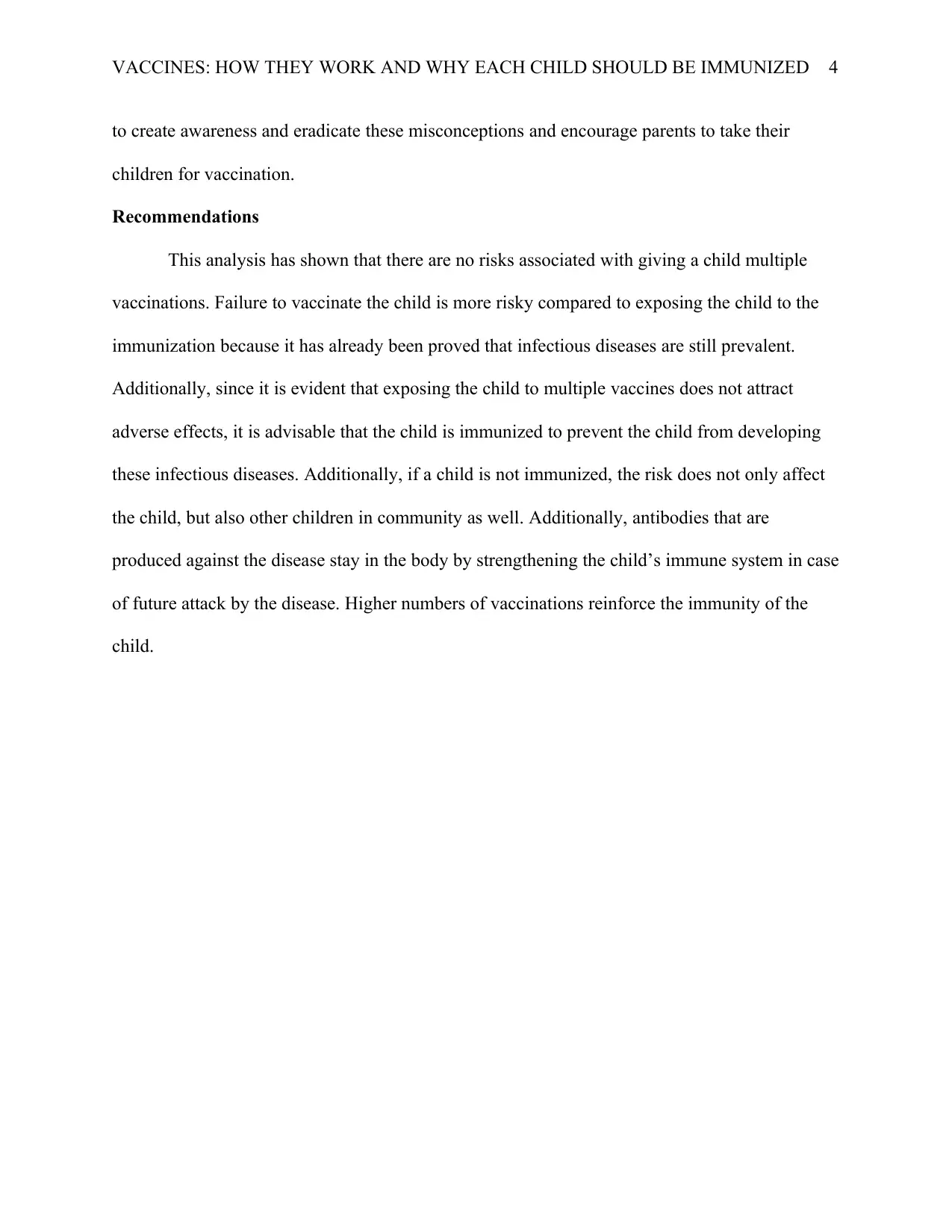
VACCINES: HOW THEY WORK AND WHY EACH CHILD SHOULD BE IMMUNIZED 4
to create awareness and eradicate these misconceptions and encourage parents to take their
children for vaccination.
Recommendations
This analysis has shown that there are no risks associated with giving a child multiple
vaccinations. Failure to vaccinate the child is more risky compared to exposing the child to the
immunization because it has already been proved that infectious diseases are still prevalent.
Additionally, since it is evident that exposing the child to multiple vaccines does not attract
adverse effects, it is advisable that the child is immunized to prevent the child from developing
these infectious diseases. Additionally, if a child is not immunized, the risk does not only affect
the child, but also other children in community as well. Additionally, antibodies that are
produced against the disease stay in the body by strengthening the child’s immune system in case
of future attack by the disease. Higher numbers of vaccinations reinforce the immunity of the
child.
to create awareness and eradicate these misconceptions and encourage parents to take their
children for vaccination.
Recommendations
This analysis has shown that there are no risks associated with giving a child multiple
vaccinations. Failure to vaccinate the child is more risky compared to exposing the child to the
immunization because it has already been proved that infectious diseases are still prevalent.
Additionally, since it is evident that exposing the child to multiple vaccines does not attract
adverse effects, it is advisable that the child is immunized to prevent the child from developing
these infectious diseases. Additionally, if a child is not immunized, the risk does not only affect
the child, but also other children in community as well. Additionally, antibodies that are
produced against the disease stay in the body by strengthening the child’s immune system in case
of future attack by the disease. Higher numbers of vaccinations reinforce the immunity of the
child.
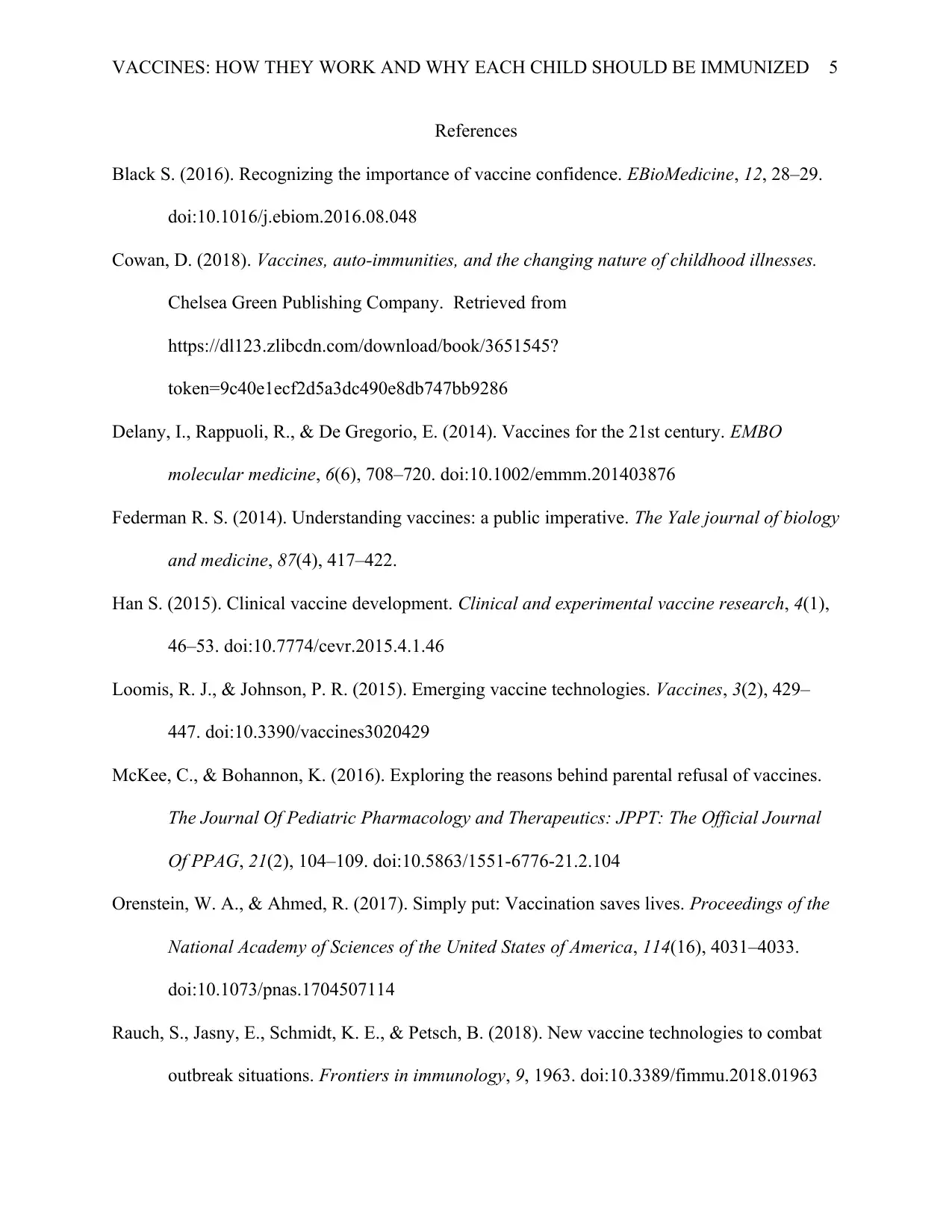
VACCINES: HOW THEY WORK AND WHY EACH CHILD SHOULD BE IMMUNIZED 5
References
Black S. (2016). Recognizing the importance of vaccine confidence. EBioMedicine, 12, 28–29.
doi:10.1016/j.ebiom.2016.08.048
Cowan, D. (2018). Vaccines, auto-immunities, and the changing nature of childhood illnesses.
Chelsea Green Publishing Company. Retrieved from
https://dl123.zlibcdn.com/download/book/3651545?
token=9c40e1ecf2d5a3dc490e8db747bb9286
Delany, I., Rappuoli, R., & De Gregorio, E. (2014). Vaccines for the 21st century. EMBO
molecular medicine, 6(6), 708–720. doi:10.1002/emmm.201403876
Federman R. S. (2014). Understanding vaccines: a public imperative. The Yale journal of biology
and medicine, 87(4), 417–422.
Han S. (2015). Clinical vaccine development. Clinical and experimental vaccine research, 4(1),
46–53. doi:10.7774/cevr.2015.4.1.46
Loomis, R. J., & Johnson, P. R. (2015). Emerging vaccine technologies. Vaccines, 3(2), 429–
447. doi:10.3390/vaccines3020429
McKee, C., & Bohannon, K. (2016). Exploring the reasons behind parental refusal of vaccines.
The Journal Of Pediatric Pharmacology and Therapeutics: JPPT: The Official Journal
Of PPAG, 21(2), 104–109. doi:10.5863/1551-6776-21.2.104
Orenstein, W. A., & Ahmed, R. (2017). Simply put: Vaccination saves lives. Proceedings of the
National Academy of Sciences of the United States of America, 114(16), 4031–4033.
doi:10.1073/pnas.1704507114
Rauch, S., Jasny, E., Schmidt, K. E., & Petsch, B. (2018). New vaccine technologies to combat
outbreak situations. Frontiers in immunology, 9, 1963. doi:10.3389/fimmu.2018.01963
References
Black S. (2016). Recognizing the importance of vaccine confidence. EBioMedicine, 12, 28–29.
doi:10.1016/j.ebiom.2016.08.048
Cowan, D. (2018). Vaccines, auto-immunities, and the changing nature of childhood illnesses.
Chelsea Green Publishing Company. Retrieved from
https://dl123.zlibcdn.com/download/book/3651545?
token=9c40e1ecf2d5a3dc490e8db747bb9286
Delany, I., Rappuoli, R., & De Gregorio, E. (2014). Vaccines for the 21st century. EMBO
molecular medicine, 6(6), 708–720. doi:10.1002/emmm.201403876
Federman R. S. (2014). Understanding vaccines: a public imperative. The Yale journal of biology
and medicine, 87(4), 417–422.
Han S. (2015). Clinical vaccine development. Clinical and experimental vaccine research, 4(1),
46–53. doi:10.7774/cevr.2015.4.1.46
Loomis, R. J., & Johnson, P. R. (2015). Emerging vaccine technologies. Vaccines, 3(2), 429–
447. doi:10.3390/vaccines3020429
McKee, C., & Bohannon, K. (2016). Exploring the reasons behind parental refusal of vaccines.
The Journal Of Pediatric Pharmacology and Therapeutics: JPPT: The Official Journal
Of PPAG, 21(2), 104–109. doi:10.5863/1551-6776-21.2.104
Orenstein, W. A., & Ahmed, R. (2017). Simply put: Vaccination saves lives. Proceedings of the
National Academy of Sciences of the United States of America, 114(16), 4031–4033.
doi:10.1073/pnas.1704507114
Rauch, S., Jasny, E., Schmidt, K. E., & Petsch, B. (2018). New vaccine technologies to combat
outbreak situations. Frontiers in immunology, 9, 1963. doi:10.3389/fimmu.2018.01963
⊘ This is a preview!⊘
Do you want full access?
Subscribe today to unlock all pages.

Trusted by 1+ million students worldwide
1 out of 6
Related Documents
Your All-in-One AI-Powered Toolkit for Academic Success.
+13062052269
info@desklib.com
Available 24*7 on WhatsApp / Email
![[object Object]](/_next/static/media/star-bottom.7253800d.svg)
Unlock your academic potential
Copyright © 2020–2025 A2Z Services. All Rights Reserved. Developed and managed by ZUCOL.





